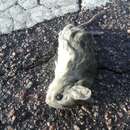en
names in breadcrumbs


Little is known about specific forms of communication in bunny rats. Like other mammals, they are likely to use chemical communication to convey reproductive state.
Communication Channels: chemical
Perception Channels: visual ; tactile ; acoustic ; chemical
Reithrodon auritus populations are protected in some national parks and reserves but are not threatened or endangered. They are listed under lower risk and sublisted as a least concern on the IUCN redlist.
US Federal List: no special status
CITES: no special status
IUCN Red List of Threatened Species: least concern
Bunny rats have become pests in some areas because they consume such large quantities of grasses. At high population densities they can deteriorate pasture quality for cattle.
Negative Impacts: crop pest
Bunny rats are important members of their native ecosystems.
Bunny rats are host to many ectoparasites. In Buenos Aires Province they are home to an endoparasite called Stilestrongylus aureus. They are also an important prey source for owls and small mammalian carnivores.
Bunny rats use burrows constructed by other species, including tuco-tucos (Ctenomys) and armadillos (Dasypodidae). They may inhabit these tunnels along with other rodent species, including long-haired grass mice (Abrothrix longipilis) and long-tailed pygmy rice rats (Oligoryzomys longicaudatus).
Ecosystem Impact: disperses seeds
Mutualist Species:
Commensal/Parasitic Species:
Reithrodon auritus mainly feeds on grasses and other plants with tuberous rhizomes and roots. The stomach contents of bunny rats in southeastern Buenos Aires province showed that their diet consisted only of plant material, mostly grasses. Lolium multiflorum and Poa species made up 74% of stomach content dry weight. The variety of grasses in stomach contents was less than the variety of grasses available, suggesting that they may specialize on only a few types of grasses. Bunny rats in captivity eat their own body mass of green vegetation every night.
Plant Foods: leaves; roots and tubers
Primary Diet: herbivore (Folivore )
Bunny rats (Reithrodon auritus), also commonly called rata conejo or coney rats, are found in the Patagonian region of Argentina, southern Chile, and parts of Uruguay.The type locality for Reithrodon auritus is on the south bank of the Rio de la plata in the southern pampas of Buenos Aires, Argentina.
Biogeographic Regions: neotropical (Native )
Reithrodon auritus is most commonly found in open habitats such as cultivated fields, pampas, stony hills, and sandy coasts. They inhabit a wide range of elevations, found sea level to 2170 meters elevation. Bunny rats live in burrows that they dig themselves or they make use of abandoned burrows made by other fossorial mammals. They also use natural cavities among rocks.
Range elevation: 0 to 2170 m.
Habitat Regions: temperate ; terrestrial
Terrestrial Biomes: savanna or grassland ; chaparral ; scrub forest
Other Habitat Features: agricultural
The average lifespan of Reithrodon auritus in the wild is 3.7 months with a maximum longevity in the wild of about 15 months. One captive bunny rat lived for 5.5 years. Lifespan is limited by predation from owls.
Range lifespan
Status: captivity: 5.5 (high) years.
Average lifespan
Status: wild: 3.7 months.
Average lifespan
Status: captivity: 5.5 years.
Bunny rats have thick, soft fur. The upper part is a mix of grayish and black hairs and the underside is whitish or grayish. An adult bunny rat has a total body length of 195 to 269 mm, tail length of 65 to 104 mm, up to 65% of body length. They have an average body mass of about 80 g and a resting metabolic rate of 0.4280 W. Some key physical features used to identify Reithrodon auritus are: they have two grooves on the enamel of the upper incisors, there is a reduction in size of the outer hind toes, the middle hind toes are webbed, and the ears are large, rounded, and covered with hair.
Range mass: 20.5 to 116 g.
Average mass: 80 g.
Range length: 21.5 to 30.5 cm.
Average basal metabolic rate: 0.4280 cm3.O2/g/hr.
Other Physical Features: endothermic ; homoiothermic; bilateral symmetry
Sexual Dimorphism: sexes alike
Average basal metabolic rate: 0.428 W.
Reithrodon auritus are main prey items throughout their range for great horned owls (Bubo virginianus), common barn owls (Tyto alba), other owl species, and buzzard-eagles. It is suggested that Patagonian opossums (Lestodelphys halli) are predators because they have been captured in the same trapline as Reithrodon auritus. Humans may eat bunny rats as well. Bunny rats don't seem to respond to noises, even as close as 2 meters away. Their cryptic coloration and escape to burrows may help protect them from predation somewhat.
Known Predators:
Anti-predator Adaptations: cryptic
The mating system of bunny rats is not well understood. It is thought that males attempt to mate with as many receptive females as they can.
Mating System: polygynous
Bunny rats are reproductively active during the spring months. Reithrodon species have been found to breed throughout the year and the number of young varies considerably, from 1 to 8 with an average of 4.53. Females become sexually mature at about two months old, before reaching a body mass of 52g. Males take a little longer to reach sexual maturity; when their seminal vesicles are longer than 12mm which is around three months of age.
Breeding season: Breeding occurs primarily in the spring months.
Range number of offspring: 1 to 8.
Average number of offspring: 4.53.
Average age at sexual or reproductive maturity (female): 2 months.
Average age at sexual or reproductive maturity (male): 3 months.
Key Reproductive Features: iteroparous ; year-round breeding ; gonochoric/gonochoristic/dioecious (sexes separate); sexual ; viviparous
Average number of offspring: 4.5.
Average age at sexual or reproductive maturity (female)
Sex: female: 61 days.
Females nurse and care for their young until they are weaned. They leave the young in their grass or fur-lined nests, providing little else in the way of protection. Males do not invest in the care of their young.
Parental Investment: precocial ; pre-fertilization (Provisioning, Protecting: Female); pre-hatching/birth (Provisioning: Female, Protecting: Female); pre-weaning/fledging (Provisioning: Female); pre-independence (Provisioning)